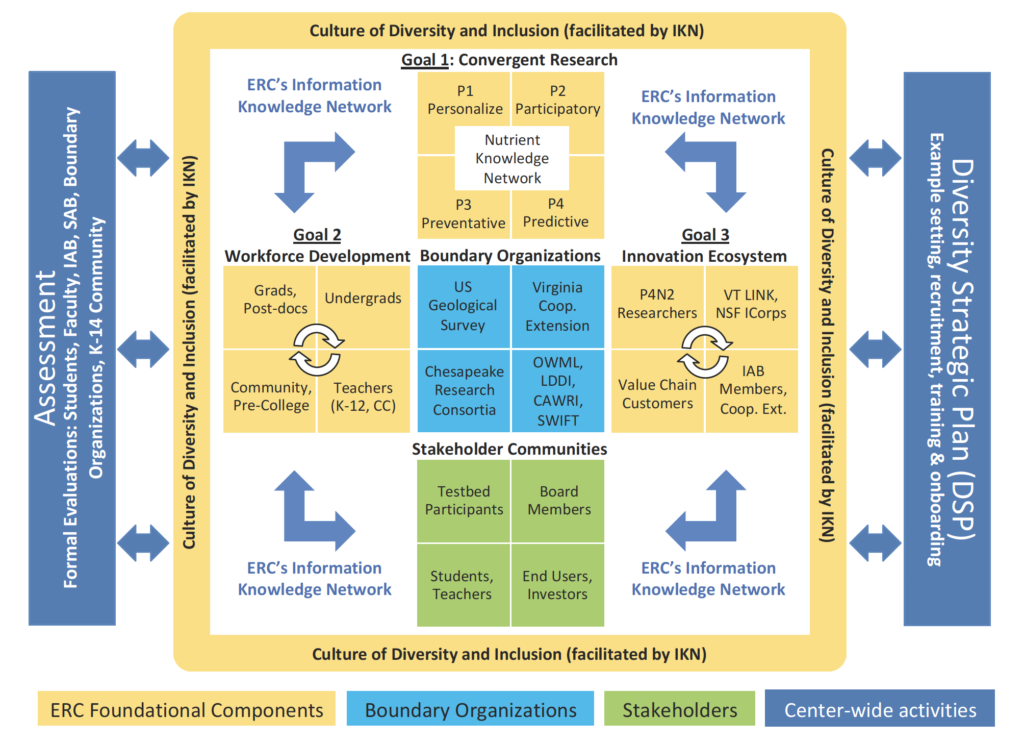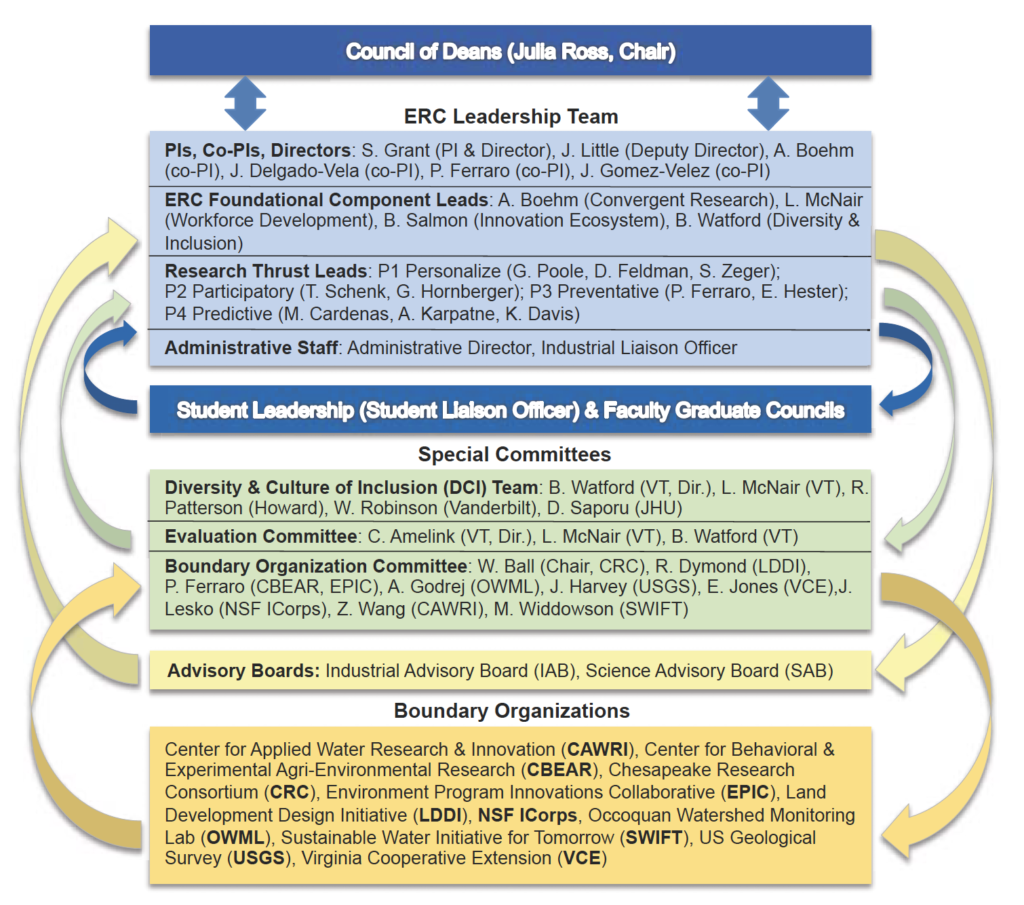As those involved with the Consortium are well aware, nutrient pollution is one of the ‘grand challenges’ of our time. It is a particularly vexing problem given the complex web of ecological, social and economic factors involved. Despite significant attention being paid to addressing nutrient pollution by governments agencies, industry, non-governmental organizations and other stakeholders, important work remains. In order to address these issues, a diverse team of researchers is applying for an NSF Engineering Research Center grant. ERCs are “interdisciplinary, multi-institutional centers that join academia, industry, and government in partnership to produce transformational engineered systems” (ERC). This nutrient pollution proposal, if funded, will span 10 years. The proposing team includes Director Stanley Grant, who recently joined the faculty at Virginia Tech, Deputy Director John Little of Tech, and co-PIs Alexandria Boehm of Stanford, Jeseth Delgado-Vela of Howard University, Paul Ferraro of Johns Hopkins, and Jesus Gomez-Velez of Vanderbilt. The CRC will also be involved, serving as a boundary organization that facilitates rich two-way dialog between the ERC and Chesapeake Bay research and practice communities, for example assisting with site selection, demonstration projects, data acquisition, and the annual co-production and public release of “clinical guidelines” and modeling tools for nutrient management.
At the heart of this ambitious proposal is the idea that outcomes can be improved and costs lowered if nutrient management is tailored to the unique socio-economic, ecological, and hydrological features of a particular site. This concept is similar to the idea behind precision or “P4” medicine, and hence the researchers are calling their ERC the Participatory, Personalized, Predictive, and Preventative Nutrient Network (P4N2). By linking breakthrough technologies coming from P4 medicine with nutrient “big data” generated by on-the-ground practitioners, special studies, routine monitoring, real-time space- and ground-based observation systems, and continental-scale simulation tools, the researchers will develop the knowledge networks and modeling frameworks needed to transfer lessons learned from one site to another. More effective means of developing, testing and disseminating best practices is necessary so that “past success stories can be replicated and mistakes avoided,” says Grant. All this while recognizing the unique nature and conditions of each place. The team will break the Bay’s watershed into 80,000 drainages and evaluate how the socio-economic and eco-hydrological features of each affected the outcomes of previous nutrient management strategies, or interventions. “The underlying philosophy is that the different drainages are going to have different responses to the same interventions,” explained Grant.

P4N2’s Strategic Plan; IKN=Information Knowledge Network
The ERC will be carried out through four research thrusts, one for each of the four P’s of P4N2. In P1 (Personalize) the researchers will utilize spatially distributed socio-economic and eco-hydrological data to stratify the Bay’s drainages into groups with similar characteristics or “nutrient risk profiles”. In P2 (Participatory), the team will conduct field surveys, interviews, and workshops at select drainages within each risk profile to elicit the dominant social narratives and stakeholder interests and priorities that must be considered in designing nutrient management interventions. This will be followed in P3 (Preventative) with cost-benefit evaluation of past interventions within each risk profile. Collectively, these results will be summarized in annually updated “clinical guidelines” for nutrient management, along the lines, “If your drainage has risk profile A and community feature B, the most cost-effective nutrient interventions may be X, Y, and Z.” These clinical profiles will be used as a starting point in P4 (Predictive) to develop system of systems (SoS) models that allow users to: (1) predict the costs and benefits of various approaches (alone or in combination) for mitigating or preventing nutrient pollution under different future scenarios; and (2) explore systems-level solutions to watershed and coastal nutrient pollution that optimize the allocation of resources over millions of drainages at continental-to-global scales.
While urban ecologists and economists have been working on environmental issues through a socio-economic lens for a long time, this might be the first time engineers, hydrologists, computer scientists, and lawyers have joined forces to tackle nutrient pollution with them. “And medicine has probably never been brought in before,” Grant joked. He explained that it boils down to humans – nutrient pollution cannot be addressed without looking at agricultural practices, stormwater management, land use change, community empowerment, and demographic issues. “We cannot address nutrient pollution without addressing human behavior,” Grant explained.

P4N2’s organizational infrastructure.
One important aspect of applying these solutions to the Chesapeake is working with Boundary Organizations that will act as a link to stakeholders, including CRC, USGS, and Virginia Cooperative Extension among others. These partners will be crucial to making sure that the ERC can support faculty and interns, meet the needs of industry, and create guidelines for nutrient management that are responsive and useful. “The Consortium is going to play an extremely vital role,” said Grant. “I am the new kid on the block, so working with the Consortium and other boundary organizations in the watershed is crucial for getting buy-in from stakeholders in the Bay and learning from what has been done over the past 30 years…Our project will rise or fall depending on how well we can engage those communities.”
The team is starting with the Chesapeake Bay watershed, but the goal is to develop an analogous system for all 2.7 million drainages in the lower 48 states, and the three plus million drainages around the globe. Grant compares this to P4 medicine, in which the goal is to improve health care for both individual patients and the population as a whole.
The journey to NSF ERC funding is a long one. Back in June, the team applied for and received an NSF ERC Planning Grant that funded several months of preparation. In January, they submitted the pre-proposal for the ERC grant, which they hope to hear back on in April, pending delays from the government shutdown. If accepted, they will be invited to submit a full proposal in July. Between now and then, the group hopes to publish a review article to help focus their ideas, and will hold a series of workshops funded by the planning grant to get stakeholders involved. “What I like about this ERC proposal is that it uses cutting edge technology to get the most out of data resources and on-the-ground knowledge that is generally underutilized or forgotten altogether,” explained Grant. He is excited to work with such a broad range of stakeholders too: “Each piece of the project feeds into the other, and collectively we have the chance to transform the way nutrients are managed locally and nationally.”
